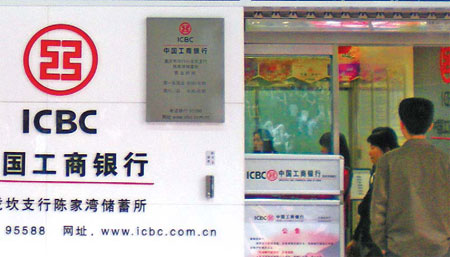 |
| Customers queue up at an ICBC branch in Chongqing. [China Daily] |
Economists and analysts have warned that complacency could lull Chinese banks into slowing their business restructuring plans, which would have helped in providing a better quality of service to their corporate and individual customers.
Chinese banks' robust profit growth in 2008, while impressive against the backdrop of the global financial crisis, hides the fact that they are over-dependent on interest income.
Domestic banks in China enjoyed significant profit growth in 2008 while most of their western peers suffered enormous losses due to the global financial crisis.
Latest figures from the China Banking Regulatory Commission (CBRC) showed that domestic banks posted a total of 583.4 billion yuan in net profit for 2008, up 30.6 percent from a year earlier.
Behind the news, however, many customers continued to vent their frustration at what they perceived as a deterioration of service rendered at many of these banks. Quite a few of them have found a channel of complaint in the Internet.
A few major city newspapers, including Beijing News and the Yangtse Evening Post, also published editorials questioning the health of China's banking industry.
While profitability in China's major State-controlled banks increased despite the global economic downturn, their collective profitability still lags behind global banks in better times.
Industrial and Commercial Bank of China's return on assets, for instance, rose to 1.21 percent last year, up from the previous year's 1.02 percent. The return on assets in China Construction Bank also rose to 1.31 percent in 2008 from 1.15 percent in 2007.
Another major State-controlled bank, Bank of China, saw its profitability declining last year due to losses from its US subprime mortgage linked investments. The bank's return on assets dropped to 1.02 percent in 2008, down from the previous year's 1.10 percent.
Citigroup, the New York-based bank that posted a fourth-quarter net loss of US$9.83 billion last year, the biggest loss in its 196-year history, hit its profitability peak in 2005 when the bank reported 1.7 percent return on assets.
Bank of America, which also reported a US$2.39 billion fourth-quarter loss in 2008, posted 1.5 percent return on assets in 2006 when its high profitability paved the way for a series of global acquisitions.
Furthermore, many analysts contend that the performance of the domestic banking industry is distorted by the dominance of the top three State-controlled banks.
"Profit in Chinese banks is highly concentrated at those State-controlled banks. Except for the 14 publicly listed banks, most other banks in China are not profitable," the Beijing News wrote in its editorial.
ICBC, the world's largest bank by market value, posted 111.2 billion yuan in net profit last year, accounting for about 19 percent of the total net profit of all domestic banks in 2008.
CCB's net profit also went up by 34 percent to 92.64 billion yuan in 2008, while BOC's net profit rose 14.42 percent to 64.36 billion yuan.
Net profit in the top three State-controlled banks in 2008 totaled 268.2 billion yuan, about 46 percent of the net profit in all domestic banks last year.
At the same time, the quality of service in Chinese banks, especially the top three State-controlled banks, was under fire from Chinese consumers.
"Chinese banks might have generated the most profit in 2008, but their service is definitely the worst in the world," an angry Internet user commented on Sina.com.
In a recent national survey of banking customer satisfaction conducted by marketing information firm Market Probe China, ICBC failed to make it to the top 10 list while CCB and BOC tied for the seventh place.
Chinese consumers have also complained about various service charges that domestic banks have implemented.
(China Daily April 15, 2009)